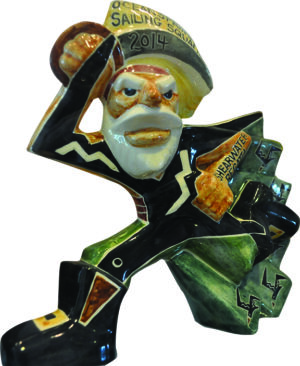A club’s trophies serve two important functions: in addition to being awards for current contests, they are a daily link with the club’s history. Yacht club trophies may come in many shapes and sizes, but the one thing they should not be is a mass-produced, multi-columned, wedding-cake-top affair with the ubiquitous figure of a small human being holding a torch, a globe, a golf club or anything else.
Yacht club trophies have been fashioned from glass or ceramic objects of art, and some clubs have trophies that were custom-made from binnacles or cannons. St. Petersburg Yacht Club (Florida) has a trophy that is awarded annually to the winner of the Royal Gaboon Race. The trophy is made from a silver cuspidor said to have been “liberated” in 1948 from a notorious New Orleans “establishment.” The club will not reveal the exact nature of the es-tablishment, but explains that “gaboon” is the French Creole word for the less colorful but more descriptive English word “spittoon,” and the race and trophy are both named for it.
Ocean Springs Yacht Club (Mississippi) has custom-made trophies available for its annual “Shearwater Regatta”—a name that is steeped in local history. The Shearwater story began in 1918 when George Walter Anderson and his wife, Annette McConnell Anderson, purchased twenty-four acres of land facing the Mississippi Sound in Ocean Springs, Mississippi. Within a few years, George retired from his business in New Orleans and moved his family to Fairhaven Mississippi, the name first given to the land now known as Shearwater. Annette’s artistic temperament provided their three sons with an appreciation of the arts that served as the foundation for a dynasty. Peter Anderson became a potter, while his brothers Walter and James (known as “Mac”) became sculptors, decorators, and painters. In 1928 the family opened Shearwater Pottery and over the years their pottery, artwork and writings developed a world-wide reputation. Although Hurricane Katrina caused severe damage to the area, much of the pottery collection was saved and Shearwater Pottery continues to produce unique pieces of the potter’s art.
Southern Yacht Club (New Orleans) had a silver pitcher that was donated in 1849 by the ladies of Pass Christian, Mississippi, to be awarded to the winner of the Club’s second regatta. The “Ladies of Pass Christian Trophy,” as it became known, was lost in the years following the American Civil War. It was presumed stolen by a man many loyal New Orleanians still call “Silver Spoon Butler,” otherwise known to history as Union General Benjamin J. Butler, who was the military governor of New Orleans during the Reconstruction years. Butler was hated and despised for a number of reasons, not the least of which was his alleged penchant for collecting silver left in New Orleans homes after they had been abandoned by their owners and invaded by his troops. Whether or not General Butler was responsible for the trophy’s disappearance, it was found in a New York City pawnshop in the early 1930s by a friend of Southern Yacht Club’s then-Commodore Garner H. Tullis. The friend purchased the trophy and gave it to the Tullis family, who returned it to the club’s collection, where it remained until the disastrous fire that followed Hurricane Katrina in 2005.
A more recent trophy-recovery story—one with a happier ending—comes from the 1996 annals of the Rhode Island Yacht Club. That year, Commodore Keith Litchfield received a telephone call from the daughter of a deceased member who explained that she had the unhappy duty of breaking up her late father’s household. Her father, Charles F. Tillinghast had been well known in the horse world and she found of number of equine trophies among his things. She mentioned that she also found some old “boating trophies” and thought the club might like to have them. “Of course,” came Commodore Litchfield’s reply, “we’d love to have them.” Commodore Litchfield later said he wasn’t expecting much when he and his vice commodore opened the UPS box that had been insured for the stan-dard fifty dollars. Then one of the trophies caught his eye. It was bigger than the others, and heavier. The bas-relief letters stood out clearly: “The Brooklyn Yacht Club Ocean Race, New York to Marblehead,” and below that title the line, “Presented by Sir Thomas Lipton, Bart. [Baronet], K.C.V.O. [Knight Commander of the Victorian Order], July 1904.” The story of how Charles Tillinghast won that 330-mile race, in a boat called Little Rhody which was only 22 feet long at the waterline could be a chapter all its own. For the purposes of this blog, suffice it to say that a Lipton Cup which had long been forgotten is today safely and securely ensconced at the Rhode Island Yacht Club thanks to the generosity of the Tillinghast family and a sharp-eyed and knowledgeable commodore.



Leave a Reply